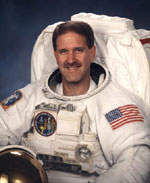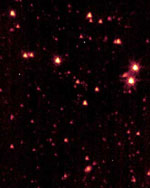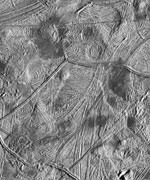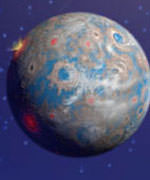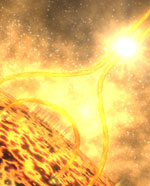
Image credit: NASA
Astronomers believe that the Sun creates and destroys antimatter as part of its natural process of fusion reaction, but new observations from NASA’s Reuven Ramaty High Energy Solar Spectroscopic Imager (RHESSI) spacecraft has brought new insights into the process. The antimatter is formed in solar flares when fast-moving particles accelerated by the flare are smashed into slower-moving particles in the Sun’s atmosphere (enough antimatter is created in just one flare to power the United States for two years). Surprisingly, the antimatter isn’t destroyed right away; instead, it’s carried by the flare to another region of the Sun before being destroyed.
The best look yet at how a solar explosion becomes an antimatter factory gave unexpected insights into how the tremendous explosions work. The observation may upset theories about how the explosions, called solar flares, create and destroy antimatter. It also gave surprising details about how they blast subatomic particles to almost the speed of light.
Solar flares are among the most powerful explosions in the solar system; the largest can release as much energy as a billion one-megaton nuclear bombs. A team of researchers used NASA’s Reuven Ramaty High Energy Solar Spectroscopic Imager (RHESSI) spacecraft to take pictures of a solar flare on July 23, 2002, using the flare’s high-energy X-rays and gamma radiation.
“We are taking pictures of flares in an entirely new color, one invisible to the human eye, so we expect surprises, and RHESSI gave us a couple already,” said Dr. Robert Lin, a faculty member in the Dept. of Physics at the University of California, Berkeley, who is the Principal Investigator for RHESSI.
Gamma-rays and X-rays are the most energetic forms of light, with a particle of gamma ray light at the top of the scale carrying millions to billions of times more energy than a particle of visible light. The results are part of a series of papers about the RHESSI observation to be published in Astrophysical Journal Letters October 1.
Antimatter annihilates normal matter in a burst of energy, inspiring science fiction writers to use it as a supremely powerful source to propel starships. Current technology only creates minute quantities, usually in miles-long machines employed to smash atoms together, but scientists discovered the July 2002 flare created a half-kilo (about one pound) of antimatter, enough to power the entire United States for two days. According to the RHESSI images and data, this antimatter was not destroyed where expected.
Antimatter is often called the “mirror image” of ordinary matter, because for every type of ordinary matter particle, an antimatter particle can be created that is identical except for an opposite electric charge or other fundamental properties.
Antimatter is rare in the present-day universe. However, it can be created in high-speed collisions between particles of ordinary matter, when some of the energy from the collision goes into the production of antimatter. Antimatter is created in flares when the fast-moving particles accelerated during the flare collide with slower particles in the Sun’s atmosphere.
According to flare theory, these collisions happen in relatively dense regions of the solar atmosphere, because many collisions are required to produce significant amounts of antimatter. Scientists expected that the antimatter would be annihilated near the same places, since there are so many particles of ordinary matter to run into. “Antimatter shouldn’t get far,” said Dr. Gerald Share of the Naval Research Laboratory, Washington, D.C., lead author of a paper on RHESSI’s observations of the antimatter destruction in the July 23 flare.
However, in a cosmic version of the shell game, it appears that this flare might have shuffled antimatter around, producing it in one location and destroying it in another. RHESSI allowed the most detailed analysis to date of the gamma rays emitted when antimatter annihilates ordinary matter in the solar atmosphere. The analysis indicates that the flare’s antimatter might have been destroyed in regions where high temperatures made the particle density 1,000 times lower than where the antimatter should have been created.
Alternatively, perhaps there is no “shell game” at all, and flares are able to create significant amounts of antimatter in less dense regions, or flares somehow may be able to maintain dense regions despite high temperatures, or the antimatter was created “on the run” at high speeds, and the high-speed creation gave the appearance of a high-temperature region, according to the team.
Solar flares are also capable of blasting electrically charged particles in the Sun’s atmosphere (electrons and ions) to almost the speed of light (about 186,000 miles per second or 300,000 km/sec.). The new RHESSI observation revealed that solar flares somehow sort particles, either by their masses or their electric charge, as they propel them to ultra-high speeds.
“This discovery is a revolution in our understanding of solar flares,” said Dr. Gordon Hurford of the University of California, Berkeley, who is lead author of one of fifteen papers on this research.
The solar atmosphere is a gas of electrically charged particles (electrons and ions). Since these particles feel magnetic forces, they are constrained to flow along magnetic fields that permeate the Sun’s atmosphere. It is believed that solar flares happen when magnetic fields in the Sun’s atmosphere become twisted and suddenly snap to a new configuration, like a rubber band breaking when overstretched. This is called magnetic reconnection.
Previously, scientists believed that the particles in the solar atmosphere were accelerated when they were dragged along with the magnetic field as it snapped to a new shape, like a stone in a slingshot. However, if it were this simple, all the particles would be shot in the same direction. The new observations from RHESSI show that this is not so; heavier particles (ions) end up in a different location than lighter particles (electrons).
“The result is as surprising as gold miners blasting a cliff face and discovering that the explosion threw all the dirt in one direction and all the gold in another direction,” said Dr. Craig DeForest, a solar researcher at the South West Research Inst. Boulder, Colo.
The means by which flares sort particles by mass is unknown; there are many possible mechanisms, according to the team. Alternatively, the particles could be sorted by their electric charge, since ions are positively charged and electrons negatively charged. If this is so, an electric field would have to be generated in the flare, since particles move in different directions in an electric field according to their charge. In either case, magnetic reconnection still provides the energy, but the acceleration process is more complex.
The clue that tipped scientists off to this surprising behavior was the RHESSI observation that gamma rays from the July 23 flare were not emitted from the same locations that emitted the X-rays, as theory predicts. According to solar flare theories, electrons and ions are accelerated to high-speeds during the flare and race down arch-shaped magnetic structures. The electrons slam into the denser solar atmosphere near the two footpoints of the arches, emitting X-rays when they encounter electrically charged protons there that deflect them. Gamma rays should be emitted from the same locations when the high-speed ions also crash into these regions.
While RHESSI observed two X-ray emitting regions at the footpoints, as expected, it only detected a diffuse gamma-ray glow centered at a different location some 15,000 kilometers (approximately 9,300 miles) south of the X-ray sites.
“Each new discovery shows we are only just beginning to understand what happens in these gigantic explosions,” said Dr. Brian Dennis of NASA’s Goddard Space Flight Center, Greenbelt, Md., who is the Mission Scientist for RHESSI. RHESSI was launched February 5, 2002, with the University of California, Berkeley, responsible for most aspects of the mission, and NASA Goddard responsible for program management and technical oversight.
Source: NASA News Release

